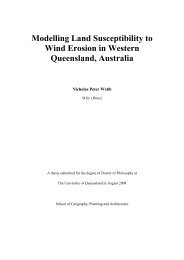Final Report: Strengthening Community Research in ... - Ninti One
Final Report: Strengthening Community Research in ... - Ninti One
Final Report: Strengthening Community Research in ... - Ninti One
You also want an ePaper? Increase the reach of your titles
YUMPU automatically turns print PDFs into web optimized ePapers that Google loves.
Two workshops were held:i. Introduction for N<strong>in</strong>ti <strong>One</strong> <strong>Strengthen<strong>in</strong>g</strong> <strong>Community</strong> <strong>Research</strong> for Remote Service DeliveryHeld <strong>in</strong> May 2011 at Ntaria, and attended by five Ntaria <strong>Community</strong> <strong>Research</strong>ers, this was an <strong>in</strong>troduction to<strong>Community</strong> research. After the <strong>in</strong>duction section the workshop discussed what an action research cycle is, talk<strong>in</strong>g abouthow the cycle progressed and what is covered with each step. The workshop explored common research terms andclarified how we use them.ii. Group workshop for Amata and Ntaria N<strong>in</strong>ti <strong>One</strong> <strong>Community</strong> research staffA similar project to the Ntaria <strong>Strengthen<strong>in</strong>g</strong> <strong>Community</strong> <strong>Research</strong> for Remote Service Delivery was be<strong>in</strong>g conductedconcurrently at Amata, and a workshop held at Yulara <strong>in</strong> June2011 brought these two groups of community researcherstogether for the first time. The benefit for community researchers meet<strong>in</strong>g other researchers from differentcommunities cannot be underestimated. Both groups provided excellent audiences for each other’s research projectreports, and gave really good feedback. This was the k<strong>in</strong>d of opportunity for skill shar<strong>in</strong>g which is only provided <strong>in</strong><strong>in</strong>ter-Aborig<strong>in</strong>al cultural exchange. Feedback from the workshop was strongly positive.3.4.2. Individual learn<strong>in</strong>gKeep<strong>in</strong>g track of learn<strong>in</strong>g and professional development <strong>in</strong> the team helped researchers and their team members tounderstand their own strengths and weaknesses, and allowed people to track their growth over time. Tools for selfevaluationdescribed each person’s skills, and may have <strong>in</strong>fluenced the focus and methods used <strong>in</strong> the research cycles.Shar<strong>in</strong>g the learn<strong>in</strong>g evaluations with others <strong>in</strong> the team gave an opportunity for listen<strong>in</strong>g to one another about how weeach work.The take-up of research jobs was affected by each person’s hopes and confidence <strong>in</strong> their own ability to ‘do’ the job. Aspreviously mentioned, one barrier to employment was English literacy and numeracy. There is a stigma of shamecommon to Aborig<strong>in</strong>al people whose first, and often second and third languages are not English. People are reticent toengage <strong>in</strong> processes where they feel their competency with English will be <strong>in</strong>terpreted as reflective of their knowledgeor <strong>in</strong>telligence. Therefore, to evaluate learn<strong>in</strong>g we used worksheet tools that aimed to be friendly to those with Englishas a second language: clear to look at and easy to talk about with others, <strong>in</strong> any language.Work<strong>in</strong>g <strong>in</strong> a group, people talked about what the questions on the worksheets might be ask<strong>in</strong>g. The worksheets alsofed <strong>in</strong>to talk<strong>in</strong>g about other th<strong>in</strong>gs that were important to people. The worksheets were designed like a survey<strong>in</strong>strument, with some multiple choice and some qualitative answers. The questions were presented <strong>in</strong> English, withgraphics, as they would be <strong>in</strong> a community survey <strong>in</strong>strument. Conduct<strong>in</strong>g the learn<strong>in</strong>g evaluation this way providedthe opportunity to talk about both the content and the method of the evaluation. The worksheets were discussed andclarified <strong>in</strong> Western Arrarnta, as researchers proceeded through the questions.The results of the learn<strong>in</strong>g evaluation are <strong>in</strong>cluded here not as a quantitative measure of learn<strong>in</strong>g <strong>in</strong> the group, but as avisual guide and report back to the <strong>Community</strong> <strong>Research</strong>ers about the results of their learn<strong>in</strong>g evaluations across bothteams from Ntaria and Amata, and about how these results can be presented.The two worksheets were given to all of the Ntaria researchers present at the Yulara workshop, and to the Amataresearchers present. The first worksheet was reflective of how people felt when they began their employment, and thesecond, given out the next day, was ask<strong>in</strong>g about how people identified their learn<strong>in</strong>g s<strong>in</strong>ce beg<strong>in</strong>n<strong>in</strong>g employment.22 <strong>F<strong>in</strong>al</strong> <strong>Report</strong>: <strong>Strengthen<strong>in</strong>g</strong> <strong>Community</strong> <strong>Research</strong> <strong>in</strong> Remote Service Delivery at Ntaria
















